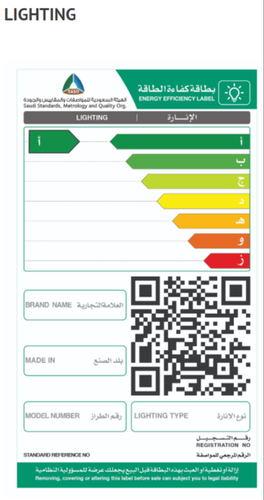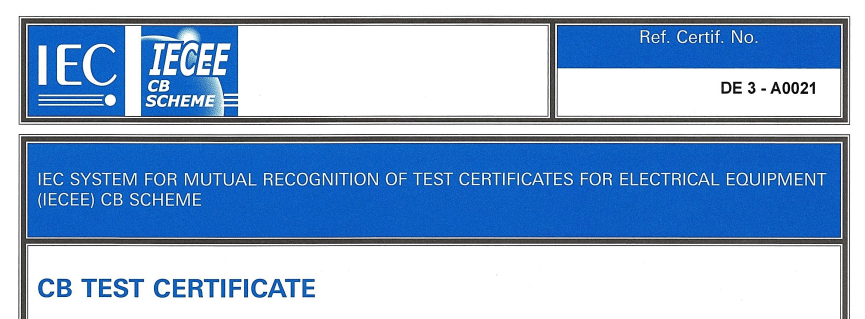When you search 'what certificates are required for importing lighting products from China to Saudi Arabia when customs clearance' on google, you will see words like EER, CB, IECEE, SABAR, maybe also PCOC, SCOC, and so on. Wow, there's a lot of jargon, it looks a bit complicated. If you don't want to study all those complicated phrases, but you need to get your goods back from Saudi Customs, this article will be useful to you.
The Relationship Between the Three
Based on the latest policy as a source, we talk backwards about the relationship between these certificates and the system, SABAR is a new online application system launched by SASO, the Saudi Arabian Standards Organisation, where you can apply for a PCOC (Product Conformity Certificate) and SCOC (Shipping Conformity Certificate) for customs clearance. The prerequisite for importers of lighting products to register on SABER is the provision of the relevant reports and certificates for IECEE certification, a new certification requirement mandatory for lighting imports into Saudi Arabia by SASO from 2019 onwards. All that is required to apply for an IECEE certificate is a CB certificate plus an EER certificate (some products are exempt). The CB certificate is based on the IEC standard for testing the safety performance of electrical products and is a mandatory certification for safety regulations. The EER is mainly for energy efficiency certification of lighting products.
In simple terms, their relationship is EER+CB→IECEE→SABER (PCOC, SCOC).
Application Requirements for Various Certifications
Knowing the relationship between them, what is worth noting when your supplier provides the relevant certificates or when you apply for them by yourself on the system?
EER Certification
The lighting products have an additional EER certification step compared to other products applying for IECEE certification. EER refers to energy efficiency certification, including life, lumen maintenance, switching cycles, start-up time, colour rendering index and power factor, etc. Some products are exempted, mainly solar street lamps, traffic signals, emergency lights and LED display lights whose main purpose is not lighting. The EER mainly includes energy efficiency testing and energy efficiency registration, and the 6,000-hour life test in the energy efficiency test requires a long test cycle. Based on this consideration, the exporter can provide a testing statement issued by a third-party institution recognised by Saudi Arabia, stating the expected completion time of the test and guaranteeing that the test report will be provided to the Saudi party within 15 days of the completion of the test, and Saudi Arabia will allow the EER registration certificate to be issued in advance.
Materials required:
model sample, label information, package picture, trademark information, manufacturer information.
Highlights:
1. EER test report lead time: 7 working days
2. EER registration cycle: 8-12 working days
3. Certificate validity: one year (specific date marked on the certificate)
4. Test reports for energy efficiency registration must be within two years
5. Different importers only need to issue one trademark authorisation to register a new importer EER trademark using the original energy efficiency report.

CB Certification
The CB test certificate is mutually recognised in the member countries of the IECEE (International Electrotechnical Commission Electrotechnical Products Conformity Testing and Certification Organisation, abbreviated as the IECEE certificate, but they are not identical). The aim is to reduce the barriers on international trade that arises from having to meet different national certifications or approval guidelines. As this CB report is subsequently used to apply for Saudi IECEE certification, the relevant test information for the product on the CB must comply with the requirements of the Saudi Bureau of Standards, and if the voltage and frequency do not correspond to those used locally in Saudi Arabia, then additional testing will be required for the national discrepancy items.
Materials required:
model parameter list, model samples (high power first when structures are the same), bare driver, component list, schematic diagram, PCB (circuit board), transformer information.
Highlights.
1. Application cycle: around 1 month
2. Validity period: three years. In practice the update time of standard shall prevail. Once the standard is updated, the certification shall be updated
3. The content of the information on the CB certificate must be correct and is the basis for other certificates such as IECEE.

IECEE Certification
IECEE certification is a new certification implemented by SASO in early 2018 to ensure that the system of standards, quality guidelines and conformance assessment issued by Saudi Arabia is in line with international guidelines and WTO requirements. If nine categories of goods covered by the certification, such as lighting products, enter the Saudi market, an IECEE certificate are needed to apply for and obtain in advance for customs clearance of goods in Saudi Arabia. The certification is implemented in phases.
Phase 1: February 2018
Mobile phones; phone chargers and their accessories; batteries (mobile phones, vehicles)
Phase 2: August 2018
Water pumps; electric motors; dishwashers; portable computers; TV equipment
Phase 3: 2019
Lighting equipment (lamps included)
Materials required:
1. Saudi standard CB certificate and its report
2. EER certificate
3. Importer and manufacturer's business licence production permit
4. Importer and manufacturer's declaration
5. Product photos, packaging printouts, real product photos
6. Instructions, PID (to indicate the difference in model name and brand name between the certified model and the CB’s tested model)
Highlights:
1. Application cycle: 15 to 20 working days.
2. Validity period: 1 year.
3. EER certification cannot be uploaded if the validity period is shorter than two months, and it needs to be ensured that it hasn’t been expired by the time the customer receives it.
4. The importer's system account information must correspond to the latest business licence
5. The parameters on the packaging must be identical to the parameters of the corresponding model in the CB
6. For some products with pins, a report on the corresponding pins is required, and for some products, a commitment letter is required.
7. One IECEE certificate can contain multiple models on the same CB certificate.
SABER System
The Saudi Product Safety Scheme, or SALEEMS, was introduced on 1st January 2018 on a trial basis, with a new online application system called "SABER" for PCPC (Product Conformity Certificate) and SCOC (batch goods conformity certificate), which will go live on 1 January 2019 and will gradually replace the old SASO-COC conformity certification. Once the IECEE certificate operation is complete, you can log on to the saber.sa website to start the importer registration process.
Importers need to enter relevant application information in the system → select an issuer in the system → pay the PCOC certificate fee → wait for the issuer to contact them and provide the required certification documents → wait for the documents to be reviewed and submitted to the SABER system by the issuer → got the PCOC certificate
After obtaining the PC certificate, you can continue to submit the SCOC certificate application to the SABER system, issue invoices, packing lists, B/L and other shipping documents, during which the issuing authority will check the validity of the PCOC certificate and issue the SCOC certificate.
Highlights:
1. PCOC is valid for 1 year
2. SCOC certificate is valid only for the imported goods of the batch
3. The SABER system requires a Saudi buyer or local merchant to register online


Other Products
For all products under SASO2870:2018 and SASO2902:2018 in the category of lighting products, the whole process of certification has to be completed. SABER system was initially implemented only for products under the control of the system, and the SASO-COC was abolished in 2020 so that almost all products exported to Saudi Arabia are included in the SABER certification system. Products that are not on the list can also apply for a SABER-SCOC certificate on the SABAR system. The following categories are briefly covered.
Category 1: The SABER system controls. Use the test report (IEC, GCC, SASO and other standards) in SABER to apply for PCOC certification, SCOC certification
Category 2: Lighting products. EER testing + EER registration + CB report + CB certificate + IECEE certification in SABER to apply for SCOC certification
Category 3: 14 types of electrical and electronic products. Use CB to apply for IECEE, then go through the SABER process.
Category 4: Food, pharmaceuticals, cosmetics, medical devices. Apply for SFDA and then go through the SABER process.
Category 5: Energy efficiency products. Make EER and then go through the SABER process.
Category 6: Ceramics and sanitary ware. Apply for water efficiency, then go through the SABER process.
Category 7: Auto parts, toys, low-voltage electrical products. Apply for GCC certification and then go through the SABER process.
Category 8: Non-regulated products. Go through the SABER process, then provide a self-declaration certificate and SCOC certificate for customs clearance.
In recent years, the Saudi Arabia market has been changing. Both exporters and importers need to pay attention to the relevant certification information timely to ensure the smooth clearance of goods.